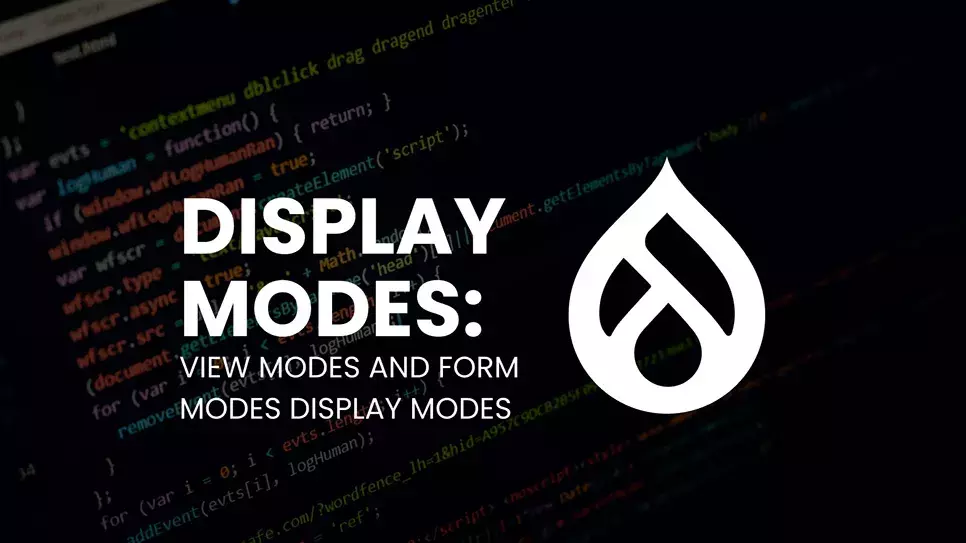Subscribe To Our NewsLetter
Share This Post:
Display Modes provides various Content Entities’ presentation for either editing or viewing. “View Modes” and “Form Modes” are the two main types of display modes, which are an instance of “Configuration Entities.”
Check below an example of a sent out “View Mode.”
uuid: 15dc7aa9-13fd-4412-9c06-06d09f915d08
langcode: en
status: false
dependencies:
module:
– node
id: node.full
label: ‘Full content’
targetEntityType: node
cache: true
reference: core.entity_view_mode.node.full.yml
“TargetEntityType” property is a primary property to observe. Each “Display Mode” (“Form Mode” or “View Mode”) is related to one, & just one, kind of “Content Entity.” However, some labels can be utilized for different “Display Modes.” For example, the standard profile of Drupal core utilizes the word “Full” in the view modes’ labels for the “Content Entity” types of custom blocks, node, and comments.
View Modes and View Displays
• Administered in total at: /admin/structure/display-modes/view
• Enabled per pack under “Custom display settings” at urls like: /admin/structure/types/manage/page/display (where ‘page’ is a heap of the node entity)
• Configured per view mode per group at urls like: /admin/structure/types/manage/page/display/teaser (where ‘page’ is a heap of the node entity and ‘teaser’ is a view mode)
“View Modes” as an idea originate before Drupal 8. They were available in Drupal 7. Drupal 6 had the idea of “build modes.” View modes exist to permit Drupal-based website developing tools like Entity Reference fields to demand a given element be rendered with a specific goal in mind.
However, the relationship between a type of entity bundle and view mode is known as a View Display. @see EntityViewDisplayInterface
Form modes and (form) operations
• Administered in total at: /admin/structure/display-modes/form
• Enabled per group at urls like: /admin/structure/types/manage/page/form-display (where ‘page’ is a heap of the node entity)
• Configured per structure mode per group at URLs like: /admin/structure/types/manage/page/form-display/simple (where ‘page’ is a heap of the node entity and ‘simple’ is a form mode).
Form modes are an approach to make diverse field designs with a similar content entity bundle, like view modes. However, the form modes take into consideration various sets of customizations as well as orderings of field widget, similarly as view modes take into consideration various sets of field formatters customization and orderings.
The field & the field widget on the “Manage fields”, we have both fields in Drupal 7. Presently this has been part into 2 tabs: “Manage fields” as well as “Manage form display.” This provides us greater adaptability over how the things will show up when somebody is taking a gander at the add/edit type of any content types. The “Manage display” tab is as yet equivalent to it was in Drupal 7. Notwithstanding content types, we can likewise oversee view modes for other element types like clients, scientific classification, remarks, and custom blocks.
Notwithstanding form modes, form tasks take into account characterizing which classes ought to be utilized for forms like a node delete form. The class used to erase a node is not the same as the class used to alter a node. Tasks are characterized by an element’s comments.
Here is a model that will delineate custom form activities, just as the “default” form mode, to the equivalent form MyEntityForm. Ensure this form extends ContentEntityForm.
/**
* @ContentEntityType(
* id = “myentity”,
* handlers = {
* “form” = {
* “default” = “Drupal\myentity\Form\MyEntityForm”,
* “add” = “Drupal\myentity\Form\MyEntityForm”,
* “edit” = “Drupal\myentity\Form\MyEntityForm”,
* “delete” = “Drupal\myentity\Form\MyEntityDeleteForm”,
* },
* },
* )
*/
On the off chance that you have to include or change accessible form tasks in existing elements you can use “hook_entity_type_build” & “hook_entity_type_alter .”
At present, there must be an express setting of activity for a form mode to be utilized. Form modes won’t utilize the ‘default’ activity as a matter of course. This could be viewed as a bug. Use _entity_form in your course, to show a form with a custom form mode. For instance, to show the custom “alter” type of the MyEntity, utilize the following course:
entity.myentity.edit_form:
path: ‘/myentity/{myentity}/edit’
defaults:
_entity_form: myentity.edit
_title: ‘Edit MyEntity’
requirements:
_permission: ‘edit myentity entities’
Another example:
A typical need is for client enlistment structures to not show all client fields. When a client is enlisted, they will approach an Edit Profile form that has extra fields. Check below the sort of configuration:
• Tap on Add Field from /admin/config/people/accounts/fields
• On the next screen, you have to select a field type, List(Text)
• Mention a Label: “Subscription List”
• Tap on “Save and continue”
• Round out the Acknowledged qualities list, for instance:
• 1|News
• 2|Important Announcements
• 3|Offers, Discounts, Specials
• 4|Partner Messages
• Tap on Save button
• Make it a Required field
• Select the entire 4 items as default and then click on save button.
• After that, tap on the “Manage form display” tab
• At the base of the field rundown is a segment marked “Custom Display Settings”, extend this.
• In the “Utilization custom showcase settings for the accompanying form modes” field empowers “Register” and snap Save.
• Now you’ll have a 2nd tab menu named “Register”.
• Disable the field of Subscription List by hauling it to the “Disabled” section. Snap save.
• Visit Manage Display tab to ensure that the Subscription List field is not visible.
Sign out of the website and go to the enrolment form. The Subscription List field will be enabled.
Once signed-in, the field of Subscription List will be accessible in the update profile form.
Share This Post:
Author Information

LN Webworks
Your Drupal Solution PartnerLN Webworks have championed open-source technologies for nearly a decade, bringing advanced engineering capabilities and agile practices to some of the biggest names across media, entertainment, education, travel, hospitality, telecommunications and other industries.
